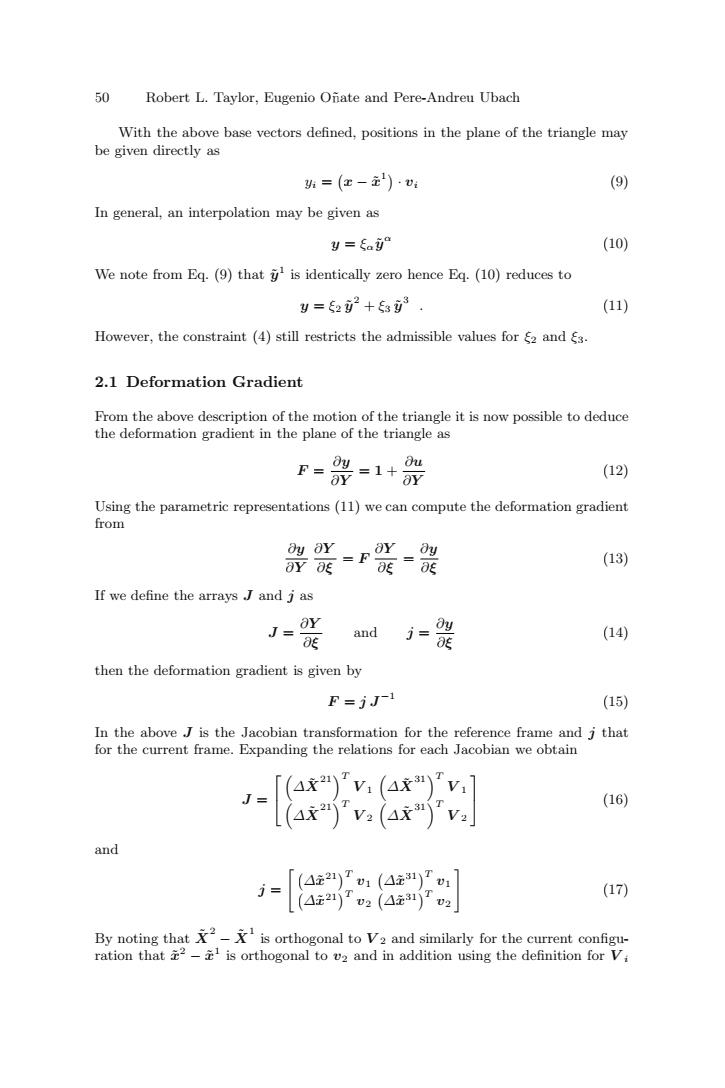正在加载图片...

50 Robert L.Taylor,Eugenio Ofate and Pere-Andreu Ubach With the above base vectors defined,positions in the plane of the triangle may be given directly as 班=(x-)·v (9) In general,an interpolation may be given as y=£a9 (10) We note from Eq.(9)that is identically zero hence Eq.(10)reduces to y=522+33. (11) However,the constraint (4)still restricts the admissible values for 2 and 3. 2.1 Deformation Gradient From the above description of the motion of the triangle it is now possible to deduce the deformation gradient in the plane of the triangle as F= dy Ψ =1+ (12) Using the parametric representations(11)we can compute the deformation gradient from ay ay aY ay Oy OE -FOEE (13) If we define the arrays J and j as J= ay and y OE j=0 (14) then the deformation gradient is given by F=jJ-1 (15) In the above J is the Jacobian transformation for the reference frame and j that for the current frame.Expanding the relations for each Jacobian we obtain (16) and j= (△221)Tu1(421)T1 (Ai2)Tv2 ()Tv2 (17) By noting that is orthogonal to V2 and similarly for the current configu- ration that 2-is orthogonal to v2 and in addition using the definition for Vi50 Robert L. Taylor, Eugenio O˜nate and Pere-Andreu Ubach ˜ With the above base vectors defined, positions in the plane of the triangle may be given directly as yi = x − x˜1 · vi (9) In general, an interpolation may be given as y = ξαy˜α (10) We note from Eq. (9) that y˜1 is identically zero hence Eq. (10) reduces to y = ξ2 y˜2 + ξ3 y˜3 . (11) However, the constraint (4) still restricts the admissible values for ξ2 and ξ3. 2.1 Deformation Gradient From the above description of the motion of the triangle it is now possible to deduce the deformation gradient in the plane of the triangle as F = ∂y ∂Y = 1 + ∂u ∂Y (12) Using the parametric representations (11) we can compute the deformation gradient from ∂y ∂Y ∂Y ∂ξ = F ∂Y ∂ξ = ∂y ∂ξ (13) If we define the arrays J and j as J = ∂Y ∂ξ and j = ∂y ∂ξ (14) then the deformation gradient is given by F = j J−1 (15) In the above J is the Jacobian transformation for the reference frame and j that for the current frame. Expanding the relations for each Jacobian we obtain J = ⎡ ⎣ ∆X˜ 21T V 1 ∆X˜ 31T V 1 ∆X˜ 21T V 2 ∆X˜ 31T V 2 ⎤ ⎦ (16) and j =
∆x˜21T v1 ∆x˜31T v1 ∆x˜21T v2 ∆x˜31T v2 (17) By noting that X˜ 2 − X˜ 1 is orthogonal to V 2 and similarly for the current configuration that x˜2 − x˜1 is orthogonal to v2 and in addition using the definition for V i